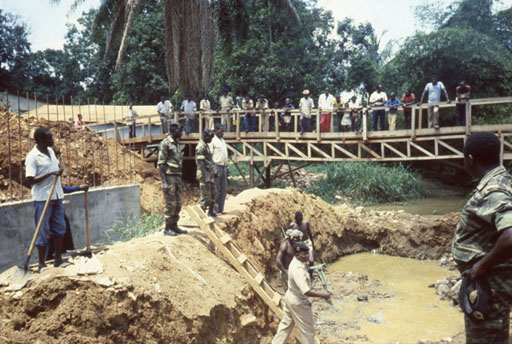In the 1980s and 1990s, the Corps helped the military forces of several countries in sub-Saharan Africa provide needed infrastructure and amenities to their military and civilian populations.
From 1985 to about 1995, the Corps of Engineers was involved in construction activities in sub-Saharan Africa as part of the Military Civic Action (MCA) program, itself a part of the larger Africa Civic Action program. The joint effort engaged personnel from the Departments of Defense and State—including the Corps, active duty military, and embassy staff—as well as citizens and soldiers of the host nations. Its primary purpose was to encourage the militaries of African nations to begin or continue to build facilities of their choosing that would directly benefit their civilian populationsor provide “dual use” to the military as well as civilians. In doing so, the MCA would enhance the expertise of military engineers while providing needed infrastructure, thereby encouraging social and economic development, promoting stability, and improving the lives of local citizens.
The Army Corps of Engineers Middle East/Africa Projects Office (a predecessor of the Transatlantic Programs Center, renamed in October 2009 the Middle East District), oversaw the MCA program in Africa. Military troops from the host nation built the projects, and Corps personnel provided engineering technical assistance in project evaluation, planning, and cost estimates; site surveys; logistical advice; oversight of implementation; and a limited amount of procurement of equipment, materials, and spare parts.
 |
|
 |
Camp du Kassai Bridge in the Central African Republic,
construction in 1989 (left) and completion in 1990 (right) |
Most of the projects were small scale, in the range of $250,000 to $500,000, and generally fell under the broad categories of education, public works, agriculture, transportation, communi-cations, or health and sanitation. Specific projects included work on a remote airfield in Niger; bridges in the Central African Republic and Mauri-tania; docks or piers in Gambia and Guinea; water projects in Ghana and Kenya; medical clinics in Ivory Coast, Malawi, Mali, Rwanda, and Senegal; schools in Sierra Leone; and housing in Djibouti and Madagascar. By 1988 the program operated in 16 countries with 21 projects completed or underway.
The results of the MCA were almost immediately apparent. Citizens in remote or underserved areas received new schools or medical clinics. The transfer of skills to host nations had a lasting effect. The program was well received by the various African armed forces, which in turn became more welcoming to U.S. agencies. In fact, one Defense employee remarked that the “mutual respect” established between the Americans and the Nigeriens was at least as important as the airfield project itself. Although the overall program was small, those involved, including the Corps of Engineers, saw outsized benefits.

Medical clinic under construction in Rwanda, 1989
* * *
November 2009
Images provided by the Middle East District.